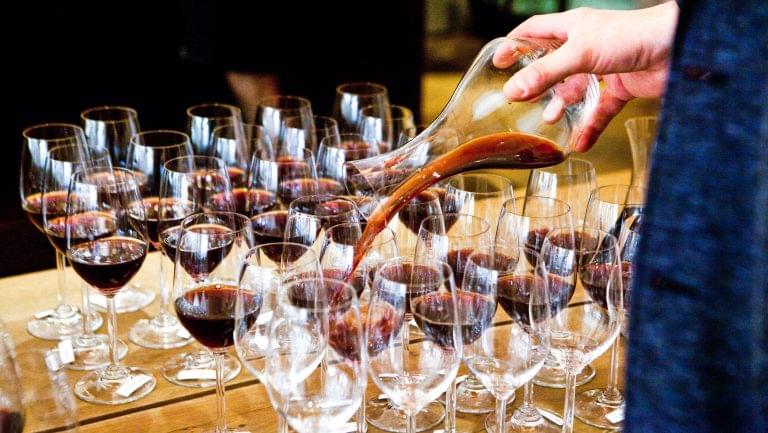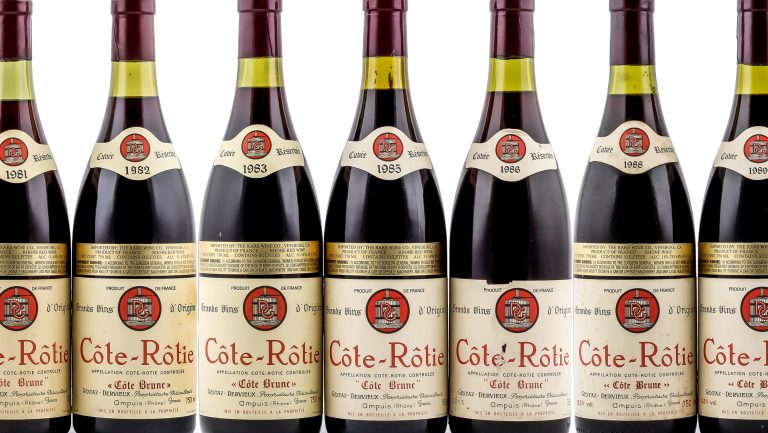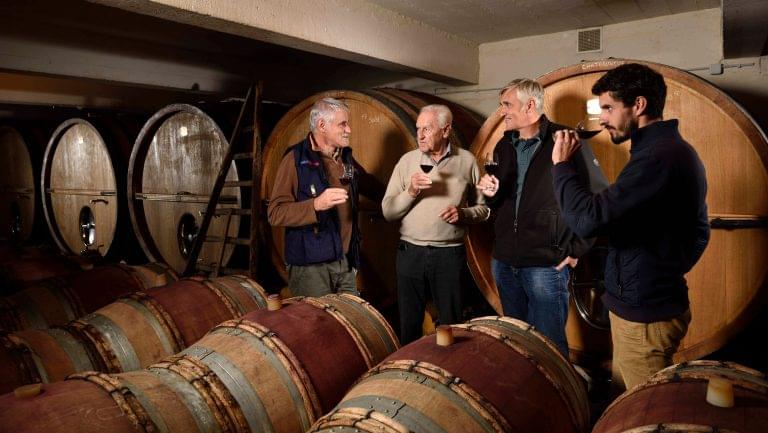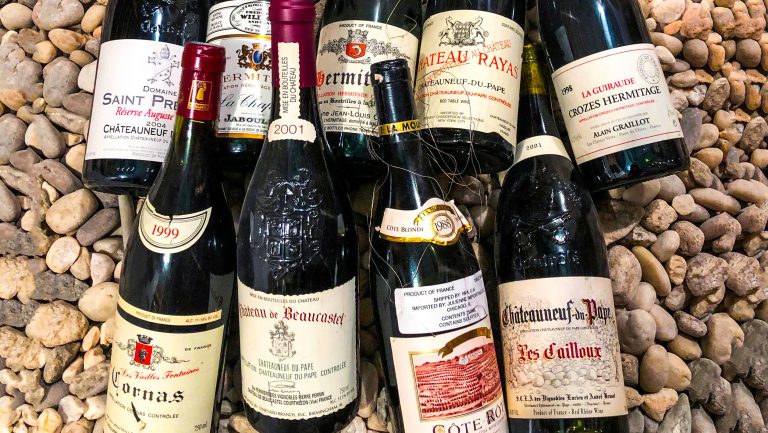“My gut says to keep it small—13 vintages, one bottle each, very high end, and focused on Gentaz. Other wines are not as big a draw.”
“It’s too much focus on one guy.”
“Pierre Rostaing is coming. He’s the great-nephew of Marius Gentaz. We could do a seminar: Gentaz, René Rostaing, Pierre Rostaing, Dervieux-Thaize.”

Don’t miss the latest drinks industry news and insights. Sign up for our award-winning newsletters and get insider intel, resources, and trends delivered to your inbox every week.
It was early November, and the sommelier and wine festival impresario Daniel Johnnes was meeting with his collaborators, Tribeca Grill wine director David Gordon and wine broker Patrick Cappiello, in his office in lower Manhattan, throwing around legendary names—but not those belonging to the faces in the photos on the walls. The photos are largely from Burgundy, the region with which Johnnes’s name is synonymous. The three sommeliers gathered that afternoon were talking instead about a fabled clan of winemakers from the Northern Rhône.
This was a planning meeting for La Tablée, a new festival that Johnnes and his team, along with Gordon, Cappiello, and West Coast winemaker, author, and Mina Group wine director Rajat Parr, are kicking off on January 30. It’s dedicated to the Rhône Valley—all of it, from the Côte-Rôtie at its geographical tippy-top to Châteauneuf-du-Pape, smack in the center of its south. Like Johnnes’s other big events, La Fête du Champagne and the Burgundy festival La Paulée, it is bringing dozens of French producers to New York to showcase their wines with the help of sommeliers from the world over, and it culminates in a grand tasting, followed by a gala dinner with free-flowing wines from producers’ and attendees’ cellars. That grand finale is slated for February 2.

During the festival, smaller meals and seminars will be held, and it was the format for one of these that the organizers were debating. In the end, they came back to Johnnes’s original idea: a dinner focused on the late, lauded Marius Gentaz, thrown at the very French La Mercerie café in Manhattan’s SoHo. The wines would come from Rare Wine Company’s Mannie Berk, who has a large collection of the coveted Gentaz bottles, and attendance would be capped at 12 guests, so each could get a 2-ounce pour of every vintage, despite any lost to decanting. They’d have some old Dervieux-Thaize as a less-expensive backup in case anything went wrong with the Gentaz wines. And though they batted around figures as high as $5,000 a head, in the end the price was set at $3,900. (For the crowd that frequents Johnnes’s events, that must have seemed like a bargain, because the Gentaz dinner quickly sold out.)
Parr was on speakerphone from California. He and Cappiello would be cohosting a seminar on Côte-Rôtie. Parr rattled off the wines they’d include: “Clusel-Roch Les Grandes Places, Gangloff La Sereine Ogier Lancement, Rostaing Ampodium, Gerin La Landonne.”
Johnnes, noting the natural wine bent of the seminar, exclaimed, “Sans souffre!”—without sulfur—but I thought he said “sans souffle,” meaning “without breath,” given the sprint-like pace of the planning process. “There’s a lot of moving parts,” Jaime Dutton, the executive director of Gracie Events, Johnnes’s festival business, told me. “There’s website management and marketing, bookkeeping, customer relations, reservations and payments, contracting venues, production and setup, partnerships and activations, staffing, managing volunteers, communicating with chefs’ teams, communicating with winemakers, and handling wine selection, shipment, and importers. It really is like a puzzle.”
Dutton’s boss happens to be a master puzzle maker. Since 2000, when the first full-scale La Paulée de New York was held, Johnnes, the wine director of Daniel Boulud’s Dinex Group and an importer, through Grand Cru Selections’ Daniel Johnnes Selections, has thrown some of the most fabled parties in wine. With festivals on the rise throughout the wine world, a look at how he and his team put the pieces together offers lessons for other wine pros who aspire to successful events of their own.
Develop Your Own Voice
Johnnes is a busy man. La Fête du Champagne was set to kick off just two days after the above-described meeting, La Paulée 2019 is slated for March, and a new venture of Johnnes’s—Pressoir.wine, a series of intimate wine gatherings—is revving up. Why would he launch another festival now—particularly when other organizers have beaten him to the finish line on the Rhône?
It’s an emotional thing. “Burgundy is not the only wine I like,” says Johnnes. “The Rhône was the first area that I went to when I first went to France [after high school], and it’s an area I really love.”
La Tablée is the fulfillment of an aspiration he’s had for years. “The first time we talked about doing this,” Dutton told me, “was in 2009, when [Rhône winemaker] Isabel Ferrando said we should cover Châteauneuf-du-Pape, and we were thinking, ‘How do we do it?’”

In 2015, producers in the Côte-Rôtie asked him about the same thing: Would he mount an event in New York, based on their own harvest dinner, also called La Tablée? When they leaked to the French press that Daniel Johnnes was going to throw them a party, it was game on.
Then Johnnes got word that two other New York sommeliers were planning an event of their own. The NoMad’s Thomas Pastuszak and Verve Wine’s Dustin Wilson are friends of Johnnes’s; they’ve worked at his other festivals. Johnnes wondered, Could they combine forces on the Rhône?
“We had a couple conversations,” recalls Pastuszak. “We just couldn’t quite align. So we said, ‘You do yours, we do ours, and we’ll go from there.’ No harm done.” Called Reboule du Rhône, Pastuszak and Wilson’s Northern Rhône festival, which benefits the charity No Kid Hungry, completed its second season in November.
Can the market handle two Rhône festivals? “Nobody will know until we come out on the other side and see,” Pastuszak says, but “we want Daniel to be successful. He’s always been a great supporter of everything we’ve done.”
That’s the thing about Johnnes: He’s a friend and supporter to all. It pained him that it might look as though he’s competing with his pals. But their event is a benefit, and his have grown into a business, with three full-time staff members. He also doesn’t like to choose sides. Pastuszak and Wilson are all about the North. “I wanted to express the whole Rhône Valley,” Johnnes says—Northern and Southern, growers and big houses. “It’s always been important that we don’t take a philosophical position that one is better than another. I don’t want to impose my opinion on a public event. I want everybody to go home and say, ‘That was fantastic!’”

The Unstoppable Daniel Johnnes
The Burgundy-obsessed wine impresario helped shape a generation of wine professionals—and is doubling down with a new festival
As for the overlap with Reboule, Johnnes says, “It draws more attention to the region. That’s a good thing. They’re good guys, and New York’s a big market. It would take a lot to saturate it.” But he has advice for anyone who wants to follow their example: “If you’re copying someone else because it’s a popular theme, that’s a problem. You have to develop your own voice and say what you want to say.”
Do It for the Region
La Tablée’s underlying statement is that there’s merit everywhere in this large wine region. That’s why Johnnes is partnering not only with Northern Rhône aficionados Cappiello and Parr but also Gordon, who has built the world’s largest Châteauneuf-du-Pape list at Tribeca Grill. These sommeliers helped recruit winemakers from both the North and the South. It’s that intermingling that jazzes them.
“The winemakers don’t get to spend a lot of time together, especially between the North and the South,” says Cappiello. “Relationships are built out of that. And the more relationships [are fostered], the better the conversation is in the actual region. Educationally, it’s really unique.”
It’s an education, too, for all the participating sommeliers. Says Gordon, “Northern Rhône has become the darling of the somms because the wines are more savory and lower in alcohol. But the pricing is high. Southern Rhône is more affordable. And a lot of consumers like those big wines. Plus, they’re not just fruit bombs. They have minerality and spice too, and few see new oak. So it’s an opportunity. When the somms get a chance to meet the producers and taste the wines, they’ll be more interested.”
Johnnes, too, is looking forward to giving the Southern Rhône some love: “I feel really good about it because it’s reintroducing an area that needs attention.”
Target Your Demographic
Rhône wines from both areas tend to be less expensive than Burgundy or Champagne. The region is considered more rustic. So La Tablée will have a more approachable and affordable feel. Its $150 grand-tasting ticket is less than half that of La Paulée’s. Festivalgoers are expected to be different, too. “Part of the intention is to appeal to a younger demo and expand our reach,” says Dutton. As at this past year’s La Fête, a First Press combo ticket for the tasting and gala is reserved for attendees under 40 years old, but it costs $595, compared with La Fête’s $995. Nearly 20 of this new package had been sold by mid-January, above Dutton’s projection.
The sommelier team as will also include “fresh faces,” says Cappiello, who, along with Gordon, is managing the wine service. “We want to introduce new, young people who haven’t had the opportunity to work La Paulée or La Fête.”
The ultimate sign of the planned demographic shift may be that Johnnes is throwing the gala not in Manhattan but in Brooklyn. Daniel Boulud will cook, along with Bar Boulud executive chef Dieter Samijn and Gregory Stawowy of Le Suprême in Lyon, France. But the lead chefs will be Brooklyn-based Frank Falcinelli and Frank Castronovo (“the Franks”), whose specialty is Italian.
The venue the team settled on, 26 Bridge Street in Dumbo—“a very cool space,” says Dutton, “a little more edgy”—has a capacity of just 375 people. Its modest size didn’t recommend it just for the vibe; it also represents a business decision. “Our capacity to sell tickets is less,” Dutton says, “but the fee is significantly less, which allows us to charge less. Because it’s the first year, we wanted to be more conservative and smaller so we can grow [the festival] organically and not be pressured.”
Mind Your Budget
That doesn’t mean Johnnes hasn’t felt the heat. At an early December meeting he said, “If I get any more nervous, I’ll have to start smoking marijuana. Is it legal here yet?”
He and his team—Dutton, webmaster Max Goldberg Liu, and client relations and event manager Justine Puaud Sylvestre—along with events consultant Siu Ki Wan, were hashing out details for the gala dinner. They’d just finished talking menu with Frank Falcinelli. Said Dutton, “We need them to do it for $75 a head.”
Table rentals, settings, and centerpieces; menus and other printed materials; pipes and drapes for curtaining off the kitchen and sommelier’s “war room”; servers and setup crew; ice and refrigeration; glassware, its transportation, and washing; wine delivery; jazz band; lighting and audio; insurance—this is a spendy evening. And though the team brainstormed to bring down costs—“We don’t need a freezer in February; ice goes on the balcony”—they wouldn’t skimp on the details.
“These things cost hundreds of thousands of dollars to put on. To give a word of advice,” Johnnes told me, “watch your budget because there are a lot of costs that you don’t expect, and you want people to find value in it—not that it’s inexpensive but that they’re getting their money’s worth.”
Dutton looked at her phone. There was a text from Falcinelli quoting $55 a person. “Perfect,” she said, relieved.
For that amount, in addition to Stawowy’s pâté en croûte and the Boulud team’s roasted guinea hen with truffles, the Franks would pass canapés; serve grilled meats, roasted vegetables, and gratinéed potatoes; and douse prunes in mascarpone. They’d also plate and serve cheeses from Napa’s Andante Dairy. Sponsors like Andante add value (“Le beurre dans les épinards,” says Johnnes—the butter in the spinach). They provide goods and services. They offer discounts to chefs. They help with promotion. In addition, sponsorship fees offset costs, allowing for a nicer venue and nicer gifts.
“But [sponsors] aren’t the nuts and bolts of our event,” says Dutton. “Companies change strategies; marketing budgets change. One year we’re working with them, and the next year they’re gone. So we make sure the budget is healthy without sponsorship.”
There are ways to keep costs down. The main venue, says Dutton, is the biggest line item. “For a raw space, you’re walking in at $6,000 to $7,500.” So Johnnes’s team will maximize the 26 Bridge rental by holding the tasting there earlier in the day, leaving three hours to flip the room before the gala. The restaurants hosting smaller events help by waiving the corkage fee or marketing the event. To host the winemakers, the team worked a connection at the Freehand Hotel in Manhattan, which, new to town, had an interest in cutting them a deal.
Spread the Word
If there’s one sponsor Johnnes can’t lose, it’s American Express. He needs the Amex mailing list: “They have very long reach.”
Once a week over the span of the ticket sales period, the company is touting La Tablée in a newsletter to cardholders. In return, Johnnes offers Amex members a two-week presale. Not only that, but two of the festival’s events—a Guigal dinner and a Châteauneuf seminar—are exclusive to cardholders, as are discounted packages, special gifts, and interactive experiences, like meet and greets with sommeliers.
Another sponsor with a long arm is Zachys. La Tablée is running full-page ads in the wine auction company’s catalogue. City Winery, which is hosting Gordon’s Châteauneuf seminar, is highlighting the event in its emailings. And, given La Tablée’s target demographic, the team is also working with Yelp, whose San Francisco correspondent is a Burgundy fan and thus a Daniel Johnnes follower. In exchange for a ticket to the tasting, the platform is spotlighting La Tablée in its newsletter. But is this the right audience for Johnnes?
“Yelp has a really big audience,” Dutton argues. “It’s all about the buzz.” And even if a $525 gala ticket is too pricey for Yelpers, La Tablée’s widely cast invitation fits Johnnes’s magnanimity. He says, “We don’t want to tell people who can and can’t come.”
Still, the biggest impact on ticket sales comes from Johnnes’s own database, grown through word of mouth. Managed through Emma marketing software, his mailing list numbers more than 5,000 people. While that might not seem like a lot, it’s a high-value crowd of collectors and enophiles who are committed to whatever new endeavor Johnnes launches.
“We have such a great open rate to our emails and a lot of direct response,” says Dutton. Though a media release went out in mid-December, there’s been little advance press. Instead, the team relies on Instagram, paying to boost posts to a broader audience. Each festival has an account, though most of the traffic generated is from Johnnes’s own 10,000-plus followers.
That speaks to the power of a singular personality for promoting events such as these. “Personality is key,” says Dutton, “especially in the beginning, to have influence and relationships to get people on board”—from winemakers to sponsors to sommeliers to consumers. Johnnes’s social media presence is at the center of an integrated strategy. “We try to be consistent and active,” Dutton says. “Any time we send an email, we connect it through social media and leverage that presence. You groom your audience. We bring them in, and we don’t let them go.”
That’s good practice for Johnnes’s business, and it helps winemakers too. “This new generation of winemakers who attended enology school or traveled, they’re aware of who their end client is,” says Johnnes. “They enjoy the power of social media, and it feels good that their wines are appreciated.”
Of course, the biggest challenge, says Dutton, is staying active on social media when the team is in the weeds of the actual event. They’ve invited influencers to festivals in the past, and that’s worked well, but Dutton is pondering investing in a dedicated person to do a takeover at La Tablée.

It’s All About the People
In the end, the goal is to make connections: winemakers to clients, sommeliers to producers, Johnnes to audience, importers to accounts. “Some producers in the Rhône are getting up there in years,” says Dutton, “and they’re not in that place in their career where they feel they need to be a part of this. They say, ‘Let me talk to my importer.’ That usually bodes well for us because importers see this as a twofold opportunity, with consumers and sommeliers. You’re touching 35 or 40 really interested sommeliers who know what they’re doing.”
At La Tablée’s grand tasting, 375 people will fill the room. Throwing sales pitches around in a crowd like that might sound like screaming into the wind. But with tight organization and smooth flow, everybody should get what they need. That comes down to teamwork.
“These events have so many moving parts, and expectations are so high. It’s a roller coaster,” says Dutton. “There’s a steep climb to the top, then it shoots down and you can’t stop it. Then it’s done. You need highly organized doers to get things done under pressure in a quick timeline.”
It takes years to hone such skills, says Cappiello. “The team that Daniel has in place I’ve seen evolve. We’re doing multiple events every year here, and they’re engaged week after week. The experience that Daniel brings to the table, I wouldn’t compare to anybody else’s. When we are fine-tuning the service side, we have people to reach out to who are concerned for the best possible quality.”
That’s important because the gala dinner’s sommelier service, especially, is a monster to coordinate. Producers’ wines must be divvied up among tables. Guests’ wines must be taken and tagged at the door with their table number, name, and serving time. “The worst thing that can happen,” says Gordon, “is that somebody brings a special bottle and no one knows where it is.” A strong support team allows the sommeliers to set aside other tasks and concentrate on the intricacies of this job.
A huge part of the team’s work is communication, of course, starting with the winemakers in the Rhône. “Everyone in the office speaks French,” says Dutton. “That’s a prerequisite.”
Johnnes’s own skill in French is at the very core of his connection to the regions he highlights. It’s the basis of the hospitality he delivers to the attendees and, even more so, to the winemakers. Festivals like La Tablée are moneymakers for him, but they’re also community builders. “I want both Guigal and Clusel-Roch to go home and say, ‘Hey, Daniel and his team are really promoting our region. They love our wines and want to encourage people to explore and buy them,’” he says. “I want the winemakers feeling it was worthwhile for them and the Rhône. If we satisfy them, then the guests are going to be happy also.”

Dispatch
Sign up for our award-winning newsletter
Don’t miss the latest drinks industry news and insights—delivered to your inbox every week.
Betsy Andrews is an award-winning journalist and poet. Her latest book is Crowded. Her writing can be found at betsyandrews.contently.com.






